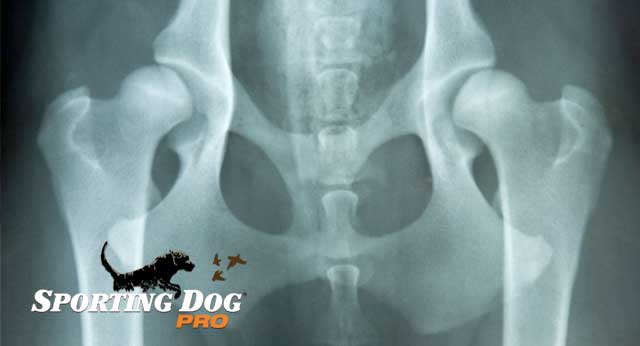You have no items in your shopping cart.
Hip Dysplasia in Dogs

Hip dysplasia is every dog owner's nightmare, not just because your dog is in pain but because dysplasia is a disease that usually ends any chance of breeding him and carrying on his wonderful personality and intelligence. The ball and socket hip joint attaches the hind leg to the body of the dog and in a normal joint the ball rotates freely within the socket and the ligament that holds the two bones together is strong and flexible. A dog with hip dysplasia has an irregular joint structure and the muscles, ligaments and connective tissue surrounding the joint are loose and unstable. The longer the disease has been developing the more distance grows between the ball and socket joint creating subluxation or a form of dislocation. Once the hip has been dislocated, the joint is faced with abnormal breakdown of the joint tissue and therefore the joint develops arthritis.
Signs and Symptoms
Normally, the symptoms of dysplasia do not reveal themselves until the latter years of the dog’s life however, even puppies as young as 5 or 6 months can display pain and discomfort during and especially, after exercise, when plagued with dysplasia. When a puppy shows signs of dysplasia, without serious intervention she could develop the worse case scenario and eventually be unable to walk.
Difficulty climbing steps is usually one of the first signs of hip dysplasia. A dog with dysplasia may start to have a notably different gait. He may go from running full force when he sees you coming to starting off slow and then easing into his normal run. As the disease progresses, he can eventually lose his interest in running altogether. He may begin to hop when he runs. Daily activities will gradually become more difficult especially if that includes jumping or climbing steps.
What are the risk factors?
Most veterinarians agree that hip dysplasia is a genetic disease and if either parent had it then their puppies are at a greater risk of developing it. Therefore, knowing the history of the parents is one way to prevent having a puppy with hip dysplasia. It is not a guarantee that your dog will have dysplasia if a parent did, but it is more likely than not. Hip dysplasia, unfortunately, is more common in the larger breeds. It is rarely seen in small breeds and purebreds seem to develop hip dysplasia more frequently than crossbreeds.
Prevention
As with most health problems, nutrition can play a role in whether a dog that is predisposed genetically to hip dysplasia, might develop the disease. Puppies who are fed automatically without pre measuring have a higher chance of developing hip dysplasia because they grow faster. It puts the puppy at risk of growing faster than is natural because, just like some human babies, some puppies don’t know when to quit eating. So therefore, obesity is also a risk factor. A dog’s joints were not meant to carry extra weight and can put an uncommon amount of pressure on the tissues and ligaments increasing the risk.
Another tip to consider in order to decrease your predisposed dog’s risk of hip dysplasia is to give him plenty of rest, especially as a puppy. Over exercising or over training especially in cold weather can increase his risk. Just listen to your pup, if he wants to rest, let him. It’s that simple. Exercise is a wonderful thing unless it is abused.
Treatment
There are fairly reliable tests, that can be performed by your veterinarian to see if your dog is at risk for hip dysplasia, especially for breeding purposes. It is always a better idea to find out before you breed so that you aren’t contributing to another generation of dogs afflicted with this dreaded disease.
If you suspect your dog already has hip dysplasia, your veterinarian can usually determine his prognosis with x-rays. If he does determine that he has hip dysplasia there are a few different methods of treatment depending on the severity. Your chances of successful treatment are increased the earlier you catch it. There are several forms of reconstructive surgery that have proven successful however, they come at a high cost. The second much more economical option is the development of several promising drugs and supplements that have been created to help your dog cope with the pain and to prevent further damage to the joint. The medicines do not cure the disease like surgery can but it can increase the quality of life for your dog.
Even though hip dysplasia is an ongoing heartache for you as a dog owner. Thanks to modern medicine and selective breeding, we can help ease and hopefully one day eliminate it.









